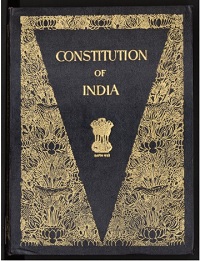Indian Polity and Constitution GK MCQs
Overview:
| Questions and Answers Type: | MCQs (Multiple Choice Questions). |
| Main Topic: | General Knowledge. |
| Sub-topic: | Indian Polity and Constitution. |
| Number of Questions: | 5 MCQs. |

Indian Polity and Constitution MCQs (Multiple Choice Questions) with answers for various state exams and UPSC civil services, SSC, banking, MPSC, UPPSC, MPPSC etc. Exams. Learn and prepare Objective type Questions on Indian Polity and Constitution.
1. Which one of the following articles deals with the annual financial statement?
- Article 112.
- Article 24.
- Article 148.
- Article 338.
Answer: (a) Article 112.
Solution: Article 112 mentions the annual financial statement (budget). Every financial year the President of India lays the annual financial statement before the House of Parliament.
Solution: Article 112 mentions the annual financial statement (budget). Every financial year the President of India lays the annual financial statement before the House of Parliament.
2. Which one of the following is not the type of majority found in India as per the Indian constitution?
- Absolute majority.
- Simple majority.
- Effective majority.
- Compound majority.
Answer: (d) Compound majority.
Solution: As per the Indian constitution, there are four types of majorities in India. They are: 1) Absolute majority- A majority of more than 50% of the total membership of the house. 2) Effective majority- A majority of more than 50% of the effective strength of the house. 3) Simple majority- A majority of more than 50% of the members present and voting in the house. 4) Special majority- A majority of two-thirds member present and voting.
Solution: As per the Indian constitution, there are four types of majorities in India. They are: 1) Absolute majority- A majority of more than 50% of the total membership of the house. 2) Effective majority- A majority of more than 50% of the effective strength of the house. 3) Simple majority- A majority of more than 50% of the members present and voting in the house. 4) Special majority- A majority of two-thirds member present and voting.
3. Which of the following is a constitutional body?
- Planning Commission.
- National Human Right Council.
- Finance Commission.
- Central Vigilance Commission.
Answer: (c) Finance Commission.
Solution: A constitutional body is an institution that created the constitution or changed it by passing a constitutional amendment bill, not by an act of parliament. They are the Election Commission, Union Public Service Commission, State Public Service Commission, Finance Commission, National Commission For SCs, National Commission for STs, Special Officer for Linguistic Minorities, Comptroller and Auditor General of India, Attorney General of India, and Advocate General of State.
Solution: A constitutional body is an institution that created the constitution or changed it by passing a constitutional amendment bill, not by an act of parliament. They are the Election Commission, Union Public Service Commission, State Public Service Commission, Finance Commission, National Commission For SCs, National Commission for STs, Special Officer for Linguistic Minorities, Comptroller and Auditor General of India, Attorney General of India, and Advocate General of State.
4. The Constituent Assembly was constituted in
- January 1950.
- November 1946.
- August 1945.
- June 1945.
Answer: (b) November 1946.
Solution: The Constituent Assembly was formulated by the Cabinet Mission Plan and constituted in November 1946.
Solution: The Constituent Assembly was formulated by the Cabinet Mission Plan and constituted in November 1946.
5. The Constituent Assembly adopted the national flag on
- May 11, 1949.
- January 24, 1950.
- July 22, 1947.
- January 26, 1950.
Answer: (c) July 22, 1947.
Solution: The Constituent Assembly adopted the national flag on July 22, 1947.
Solution: The Constituent Assembly adopted the national flag on July 22, 1947.
General Knowledge Questions
Indian Polity and Constitution
Indian Polity and Constitution GK MCQs-1
Indian Polity and Constitution GK MCQs-2
Indian Polity and Constitution GK MCQs-3
Indian Polity and Constitution GK MCQs-4
Indian Polity and Constitution GK MCQs-5
Indian Polity and Constitution GK MCQs-6
Indian Polity and Constitution GK MCQs-7
Indian Polity and Constitution GK MCQs-8
Indian Polity and Constitution GK MCQs-9
Indian Polity and Constitution GK MCQs-10
Indian Polity and Constitution GK MCQs-11
Indian Polity and Constitution GK MCQs-12
Indian Polity and Constitution GK MCQs-13
Indian Polity and Constitution GK MCQs-14
Indian Polity and Constitution GK MCQs-15
Indian Polity and Constitution GK MCQs-16
Related Topics
Basic General Knowledge
Biology
Books and Authors
Chemistry
Famous Places
Indian Famous Personalities
Important Dates and Days
Indian Art & Culture
Indian Economy
Indian Environment and Biodiversity
Indian Geography
Indian Ancient History
Indian Medieval History
Indian Modern History
Indian Polity and Constitution
Indian Organizations
International Organizations
Physics
Physical Geography
Sports
World Geography